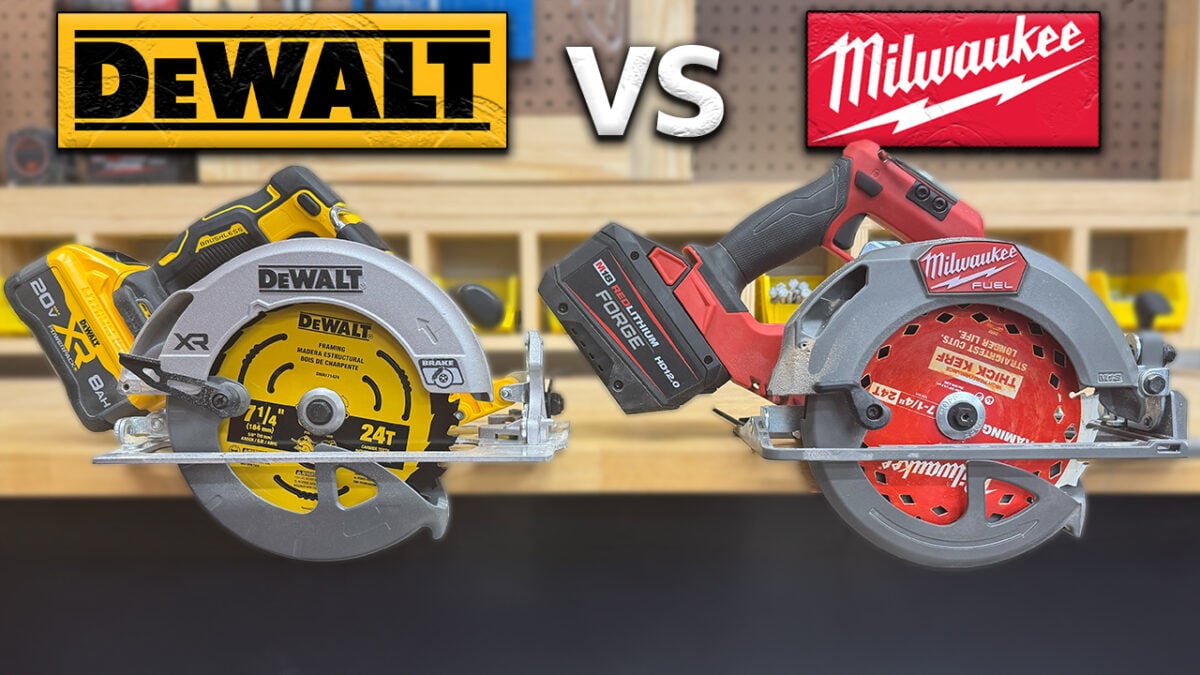Our Experts Test Two Brand-New Cordless Circular Saws Head-to-Head
Both the DeWalt 20V Max XR DCS590 and Milwaukee M18 Fuel 2834 circular saws are in the upper tier of what cordless tools have to offer. They employ advanced batteries, brushless motors, and electronics packages to deliver much higher performance than standard cordless tools can give you.
On paper, these saws are pretty evenly matched, but how will they perform head-to-head? Let’s dive in and find out!
Want to watch this as a video?
In This Head-to-Head Review
- DeWalt vs Milwaukee Circular Saw Basics
- Cutting Power
- Dust and Chip Removal
- Accuracy
- Movement
- Ergonomics
- Features
- Price and Value
- Final Results
- Key Takeaways
Editor’s note: Check out our in-depth breakdown of Milwaukee vs DeWalt as tool brands and companies.
Milwaukee M18 Fuel VS DeWalt 20V Max Circular Saw on Paper
DeWalt 20V Max 7 1/4-Inch Circular Saw
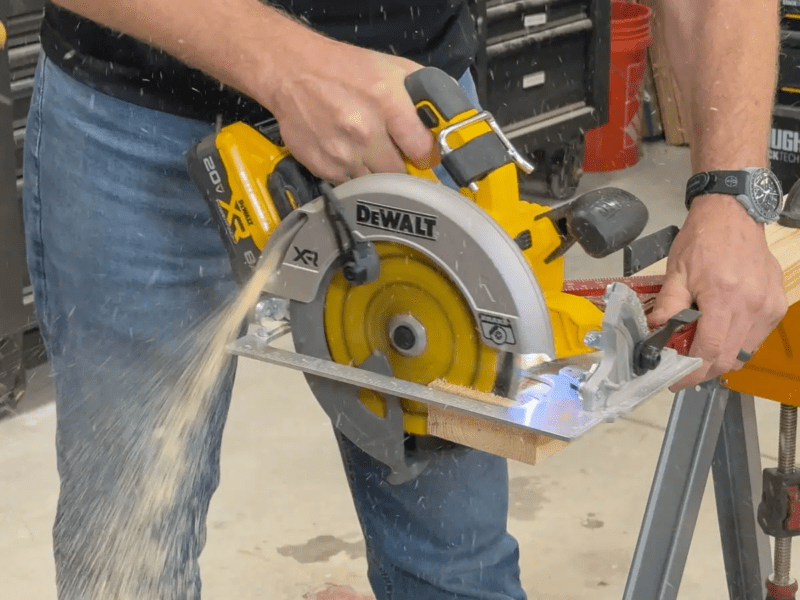
DeWalt’s latest 20V circular saw, the DCS590, is paired with their newest XR PowerPack tabless battery pack to deliver improved cutting power under load. This battery is ideal for high-draw tools, like circular saws, and the tabless design allows a more efficient power transfer and heat dissipation without having to step up to heavier FlexVolt batteries.
- Voltage: 20V Max
- Blade Size: 7 1/4-inch
- Blade Orientation: Right
- No-Load Speed: 5500 RPM
- Bevel Capacity: 57º
- Cutting Depth at 90º: 2-9/16 inches
- Cutting Depth at 45º: 2 inches
Milwaukee M18 Fuel 7-1/4 Inch Circular Saw

Much like DeWalt, the Milwaukee 2834 M18 Fuel circular saw is powered by Milwaukee’s advanced M18 Forge batteries. This matchup allows the PowerState brushless motor to pull more power from the battery, giving it a noticeable power boost over the M18 Fuel 2732. This also results in a faster top speed, making it a compelling option for Pros who want to retire their 15-amp corded saws without sacrificing power.
- Voltage: 18V
- Blade Size: 7 1/4-inch
- Blade Orientation: Right
- No-Load Speed: 6000 RPM
- Bevel Capacity: 57º
- Cutting Depth at 90º: 2-5/8 inches
- Cutting Depth at 45º: 2-1/16 inches
Milwaukee M18 Fuel VS DeWalt 20V Max Circular Saw Testing
We tested these saws with the blades and batteries that came in the kits. The batteries and blades factor into any circular saw’s performance, and if we were to match batteries as closely as possible and use the same blade, we would have fewer variables in the mix. For this test, we wanted to give you an idea of what to expect based on how each saw is configured by the manufacturer.
Cutting Performance
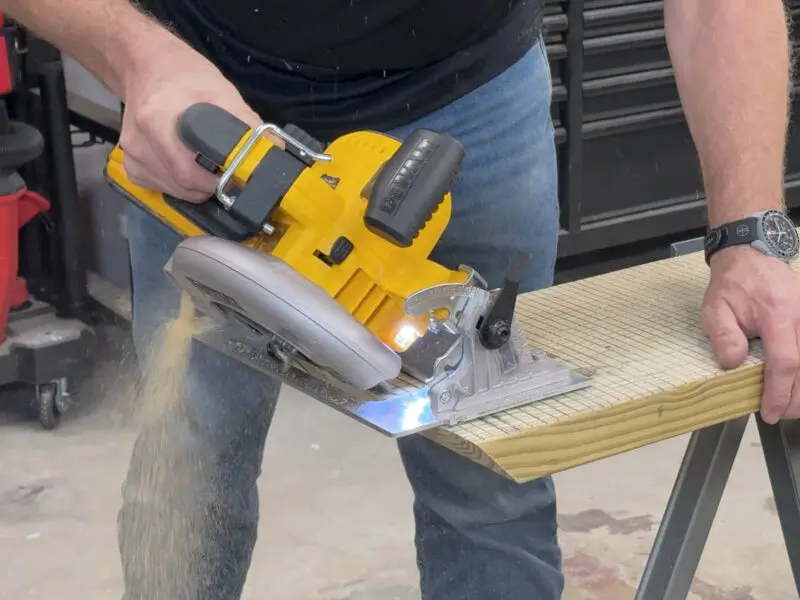
Circular saws make two basic kinds of cuts, cross cuts and rip cuts. There are variations on that with bevels and miters, but they all start with the same foundation.
The first thing we had to do was get set up for our tests. We want to mimic real-world conditions as much as possible, but we also want to keep the materials as consistent as we can. Knots, density, and moisture can all make cuts vary from one board to the next. So we use a combination of 3/4-inch OSB subfloor and pressure-treated 2x in different tests.
For our first test, we wanted to see which saw has better power. We clamped up two sheets of OSB and ran both saws across the short side to see which one we could push harder without bogging.
Both saws performed well and advanced through the cuts with ease. I did notice a slight power advantage from Milwaukee, likely due to the hefty Forge 12.0Ah battery, but DeWalt’s 8.0Ah PowerPack battery certainly held its own. In the end, I have to say that Milwaukee took the win in this test.
Next, we set up a 2×10 and conducted a series of cross, bevel, miter, and compound cuts. Overall, both saws handled the cross, bevel, and miter cuts with flying colors, but there was a noticeable difference during the compound cut.
The Milwaukee 2834 had no issues, but DeWalt struggled to complete the cut. I don’t believe this was due to a lack of power; rather, it seemed like the guard got hung up on the board halfway through the cut. Granted, this is a pretty rare cut outside of framing and specialized trim applications, but it just goes to show how much the blade guard design can affect the overall cutting experience.
Either way, it’s clear that both of these saws are in the top tier of the power you can get from a cordless circular saw. With that decided, we moved onto dust and chip removal.
- Power Winner: Milwaukee
- Cross Cut Winner: Tie
- Miter Cut Winner: Tie
- Bevel Cut Winner: Tie
- Compound Cut Winner: Milwaukee
Dust and Chip Removal
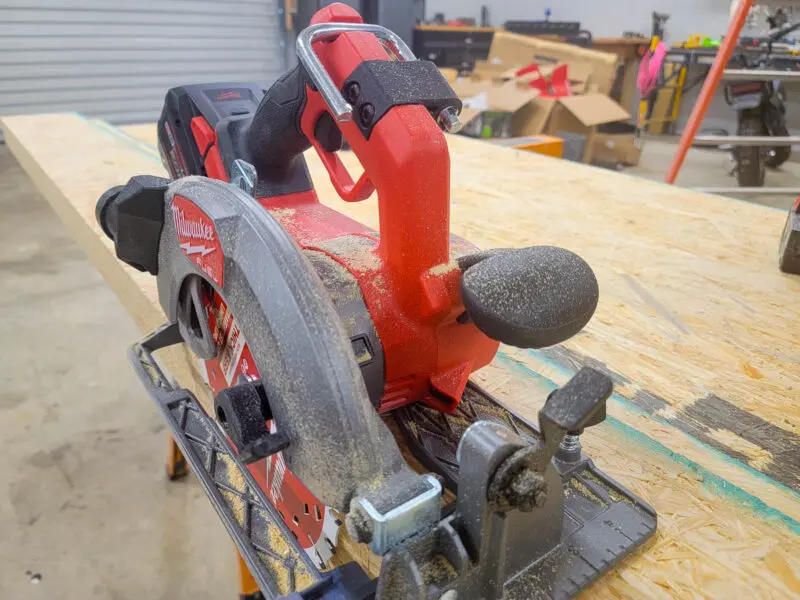
Dust and chip removal is important to help keep your cutline clear. If you can’t see your cutline due to excessive dust and debris, it can be pretty hard to make an accurate cut.
During our testing, both saws left a little bit of debris around the line, but it was pretty hard to say if one was truly superior. Both saws feature large chip ejection chutes, LED work lights, and cutline blowers that help keep the surface visible and clear of debris.
Both saws have dust port vacuum adapters, which completely change the game if you’re cutting inside or trying to contain the mess. Using a vacuum not only helps keep the cutline clear but also eliminates most of the mess you’d have to clean up later.
With all of the projects we do in our shop, using a vacuum with our circular saws is a big timesaver at the end of the day when we’re winding down. Plus, reducing airborne dust and debris makes for a safer jobsite environment.
- Winner: Tie
Accuracy
Our accuracy test consists of three parts: the sightline to the blade, the accuracy of the notches in the shoe, and how well the saw tracks.
As a right-handed user, my primary line of sight to the blade is from the left side of the upper blade guard. This can be a pretty narrow window based on the saw’s configuration, but it’s better than craning my neck over to see the right side of the blade during a cut!
I have to give Milwaukee the win in this category because its viewing window is less obstructed than DeWalt’s when cutting at 90°. Now, let me clarify: Milwaukee’s is also slightly obstructed, but not as much as DeWalt’s if you prefer to follow the blade’s contact with the line instead of using the shoe notches. However, if you position yourself further behind the saw while cutting, the view improves for both tools.
The shoe notches on both saws were dead on with our blade at both 0º and 45º, and the handle design doesn’t encourage you to push right or left away from your cutline.
- Sightline Winner: Milwaukee
- Notch Accuracy Winner: Tie
- Tracking Winner: Tie
Movement
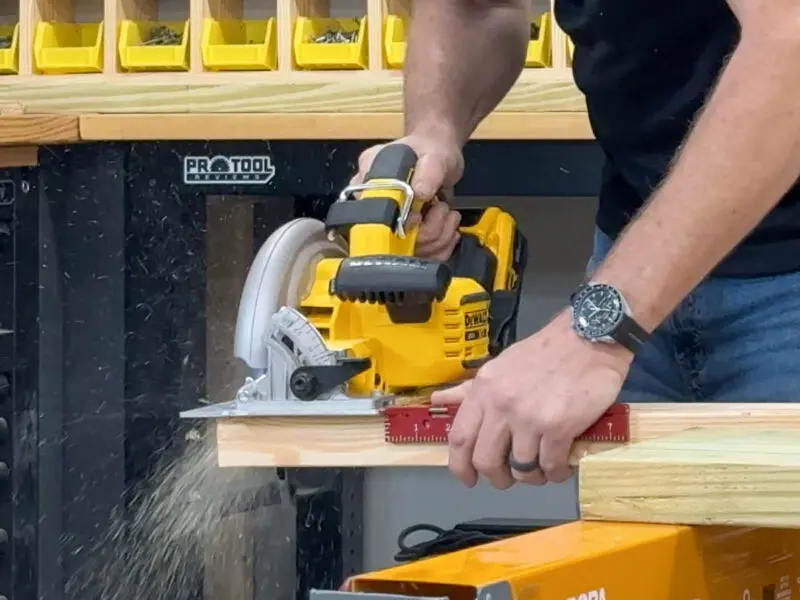
There are two things we evaluate on the saw’s movement. The most important is how smooth the guard action is on a wide variety of cuts. The other is how much friction the shoe has as it glides over your workpiece during the cut.
DeWalt’s guard action smoothly lifted over nearly every cut we made, but it did have a tendency to hang up during compound miter cuts. But as I mentioned earlier, that’s not a very common cut for most folks, so it’s certainly not a dealbreaker.
Milwaukee matched DeWalt cut for cut on its guard action but didn’t hang up on any of them. This is an impressive feat and is an excellent display of its Pro-grade pedigree.
On the other hand, shoe friction is a sticky situation for DeWalt. This saw features an unpolished aluminum shoe that doesn’t glide as well as Milwaukee’s coated magnesium shoe. We really noticed this during our 4-foot rip cuts.
The 2834’s shoe features a slick coating that offers less sliding resistance than DeWalt’s raw-milled finish. It’s not as noticeable during regular cross-cuts, but this is definitely a point for Milwaukee.
While it’s still a close race, Milwaukee is pulling ahead of DeWalt after these tests.
- Guard Action Winner: Milwaukee
- Shoe Friction Winner: Milwaukee
Ergonomics
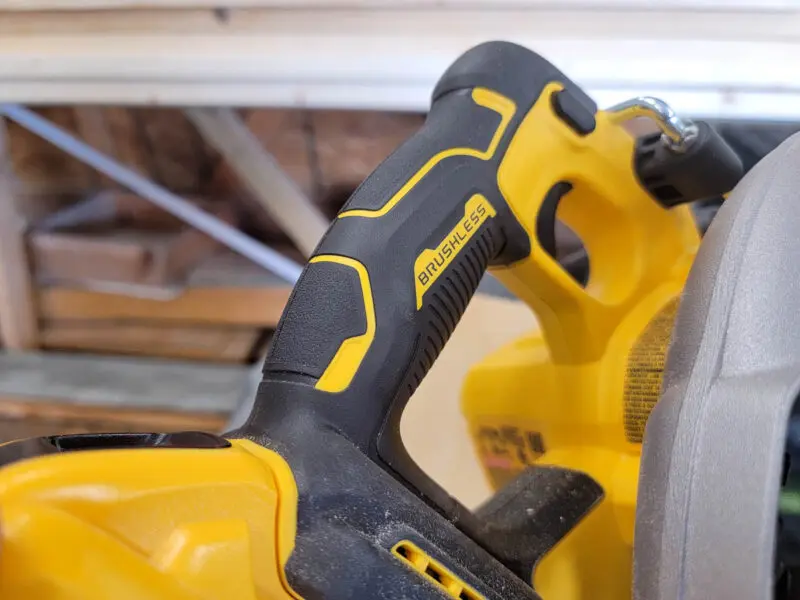
It’s debatable how much weight comes into play with a circular since it’s not as typical to cut vertically or overhead. Still, you have to haul your circular saw around, so the lighter, the better.
Neither one of these saws comes in as light as most sidewinder styles and the large batteries don’t help matters much. Milwaukee’s 2834 is 8.4 pounds bare and a hefty 11.8 pounds with its 12.0Ah Forge battery.
DeWalt is pretty close to Milwaukee’s bare weight, but the batteries make a difference. It’s 8.3 pounds bare and its 8.0Ah battery brings it up to 10.4 pounds. DeWalt is using a smaller battery, but even with an 8.0Ah Forge battery, Milwaukee is still nearly half a pound heavier at 10.8 pounds.
Moreover, Milwaukee measures 14 inches from tip to tail, while DeWalt has a total length of 12.3 inches. So, not only is DeWalt lighter, it also has a smaller profile that won’t take up as much storage space.
Looking at handle ergonomics, the two saws are nearly identical in their shape and overall design. Even though they’re very similar, we like DeWalt’s handle ergonomics better, with its front pommel grip having a larger and more comfortable working position than Milwaukee’s.
- Weight Winner: DeWalt
- Size Winner: DeWalt
- Ergonomics Winner: DeWalt
Feature Sets
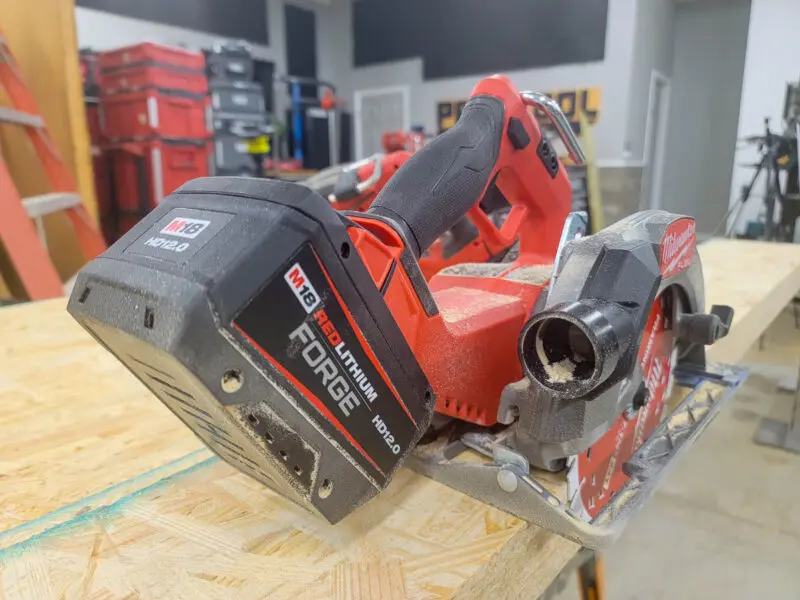
When it comes to features, both saws tick many key boxes: advanced brushless motors, blade brakes, LED lights, cutline blowers, and rafter hooks.
Milwaukee includes its vacuum adapter, while DeWalt doesn’t. You have to pick it up separately. It’s a minor inconvenience, but it may not be a deciding factor if you’re primarily working outdoors.
- Winner: Tie
Price and Value
So let’s talk about price and value. Milwaukee’s M18 Fuel runs $249 as a bare tool and $449 with a 12.0Ah Forge battery and charger.
DeWalt’s DCS590 will set you back $249 as a bare tool and $349 with a 8.0Ah PowerPack battery and charger, making it a little less expensive, even though it doesn’t have as large of a battery in the kit.
Milwaukee gives you better warranty coverage with their 5-year plan while DeWalt settles in with a 3-year warranty and 1-year service agreement.
- Price Winner: DeWalt
- Warranty Winner: Milwaukee
Final Results
| DeWalt DCS590 | Milwaukee 2834 | |
|---|---|---|
| Cutting Power | ✔ | |
| Cross Cuts | Tie | Tie |
| Miter Cuts | Tie | Tie |
| Bevel Cuts | Tie | Tie |
| Compound Cuts | ✔ | |
| Dust and Chip Removal | Tie | Tie |
| Sightline | ✔ | |
| Notch Accuracy | Tie | Tie |
| Tracking | Tie | Tie |
| Guard Action | ✔ | |
| Shoe Friction | ✔ | |
| Weight | ✔ | |
| Size | ✔ | |
| Ergonomics | ✔ | |
| Features | Tie | Tie |
| Price | ✔ | |
| Warranty | ✔ |
DeWalt 20V Max VS Milwaukee M18 Fuel Circular Saw Key Takeaways
- When it comes to overall performance and warranty coverage, Milwaukee’s 2834 has the advantage.
- DeWalt’s DCS590 is the way to go if you prioritize ergonomics or kit price.
- Both saws are at the top of the chain for their respective battery systems.
- DeWalt fans can get higher performance from 60V Max saws on the FlexVolt system.
My preference is DeWalt because the size, weight, and ergonomics are a big deal for me. Even though Milwaukee’s performance is clearly better, it’s not so far ahead that I feel like I’m missing out. But that’s just me.
On the other hand, Kenny prefers Milwaukee. He likes the higher performance and DeWalt’s shoe friction is a significant pain point for him.
Of course, that’s why we did so much testing and shared all the results. Everyone’s a little different, and it’s up to you to decide what your highest priorities are!

